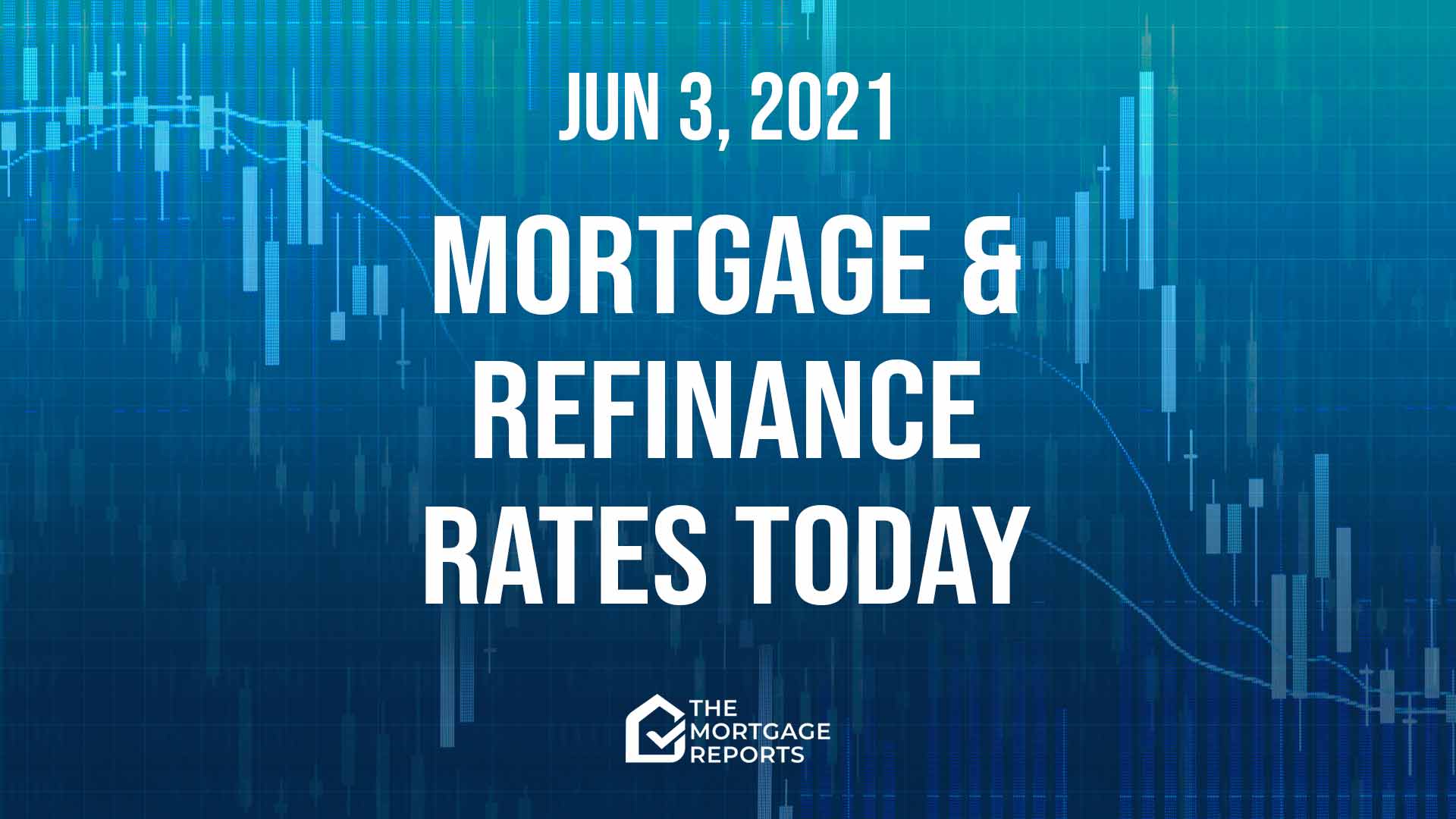
Today’s mortgage and refinance rates
Average mortgage rates edged lower yesterday. No cause to hang out the flags. But every little bit helps.
So far this morning, it’s looking as if mortgage rate today might inch higher or remain steady.
Find and lock a low rate (Jun 3rd, 2021)Current mortgage and refinance rates
| Program | Mortgage Rate | APR* | Change |
|---|---|---|---|
| Conventional 30 year fixed | |||
| Conventional 30 year fixed | 2.952% | 2.952% | -0.03% |
| Conventional 15 year fixed | |||
| Conventional 15 year fixed | 2.245% | 2.245% | -0.01% |
| Conventional 20 year fixed | |||
| Conventional 20 year fixed | 2.757% | 2.757% | -0.09% |
| Conventional 10 year fixed | |||
| Conventional 10 year fixed | 1.976% | 2.012% | -0.1% |
| Conventional 5 year ARM | |||
| Conventional 5 year ARM | 3.875% | 3.312% | Unchanged |
| 30 year fixed FHA | |||
| 30 year fixed FHA | 2.781% | 3.438% | -0.03% |
| 15 year fixed FHA | |||
| 15 year fixed FHA | 2.496% | 3.096% | Unchanged |
| 5 year ARM FHA | |||
| 5 year ARM FHA | 2.5% | 3.188% | -0.01% |
| 30 year fixed VA | |||
| 30 year fixed VA | 2.375% | 2.547% | Unchanged |
| 15 year fixed VA | |||
| 15 year fixed VA | 2.25% | 2.571% | Unchanged |
| 5 year ARM VA | |||
| 5 year ARM VA | 2.5% | 2.366% | -0.01% |
| Rates are provided by our partner network, and may not reflect the market. Your rate might be different. Click here for a personalized rate quote. See our rate assumptions here. | |||
COVID-19 mortgage updates: Mortgage lenders are changing rates and rules due to COVID-19. To see the latest on how coronavirus could impact your home loan, click here.
Should you lock a mortgage rate today?
Mortgage rates continue to rise and fall within a very tight range. So, in recent weeks, it’s really mattered little whether you’ve floated your rate or locked it.
However, that’s not the end of the story. Precious few economists expect mortgage rates to fall consistently anytime soon. And most think those rates will begin another rising trend shortly.
So floating isn’t about waiting for sustained falls. Indeed, there’s a risk those rises will be sharp when they eventually arrive.
And that’s why my personal, overall rate lock recommendations must remain:
- LOCK if closing in 7 days
- LOCK if closing in 15 days
- LOCK if closing in 30 days
- LOCK if closing in 45 days
- LOCK if closing in 60 days
However, I don’t claim perfect foresight. And your personal analysis could turn out to be as good as mine — or better. So you might choose to be guided by your instincts and your personal tolerance for risk.
Market data affecting today’s mortgage rates
Here’s a snapshot of the state of play this morning at about 9:50 a.m. (ET). The data, compared with roughly the same time yesterday, were:
- The yield on 10-year Treasurys edged up to 1.62% from 1.59%. (Bad for mortgage rates.) More than any other market, mortgage rates normally tend to follow these particular Treasury bond yields, though less so recently
- Major stock indexes were lower on opening. (Good for mortgage rates.) When investors are buying shares they’re often selling bonds, which pushes prices of those down and increases yields and mortgage rates. The opposite may happen when indexes are lower
- Oil prices climbed to $69.01 from $67.98 a barrel. (Bad for mortgage rates*.) Energy prices play a large role in creating inflation and also point to future economic activity.
- Gold prices tumbled to $1,871 from $1,910 an ounce. (Bad for mortgage rates*.) In general, it’s better for rates when gold rises, and worse when gold falls. Gold tends to rise when investors worry about the economy. And worried investors tend to push rates lower
- CNN Business Fear & Greed index — held steady at 46 out of 100. (Neutral for mortgage rates.) “Greedy” investors push bond prices down (and interest rates up) as they leave the bond market and move into stocks, while “fearful” investors do the opposite. So lower readings are better than higher ones
Caveats about markets and rates
Before the pandemic and the Federal Reserve’s interventions in the mortgage market, you could look at the above figures and make a pretty good guess about what would happen to mortgage rates that day. But that’s no longer the case. We still make daily calls. And are usually right. But our record for accuracy won’t achieve its former high levels until things settle down.
So use markets only as a rough guide. Because they have to be exceptionally strong or weak to rely on them. But, with that caveat, so far mortgage rates today look likely to be just slightly higher or perhaps unchanged. However, be aware that intraday swings (when rates change direction during the day) are a common feature right now.
Find and lock a low rate (Jun 3rd, 2021)
Important notes on today’s mortgage rates
Here are some things you need to know:
- Typically, mortgage rates go up when the economy’s doing well and down when it’s in trouble. But there are exceptions. Read ‘How mortgage rates are determined and why you should care
- Only “top-tier” borrowers (with stellar credit scores, big down payments and very healthy finances) get the ultralow mortgage rates you’ll see advertised
- Lenders vary. Yours may or may not follow the crowd when it comes to daily rate movements — though they all usually follow the wider trend over time
- When daily rate changes are small, some lenders will adjust closing costs and leave their rate cards the same
- Refinance rates are typically close to those for purchases. But some types of refinances are higher following a regulatory change
So there’s a lot going on here. And nobody can claim to know with certainty what’s going to happen to mortgage rates in coming hours, days, weeks, or months.
Are mortgage and refinance rates rising or falling?
Today and soon
Watch out for tomorrow morning’s monthly employment situation report. Those official figures are more than capable of disrupting markets and affecting mortgage rates. Of course, whether those rates go up or down or remain steady will depend on how good or bad the numbers are. But stand by to move quickly if you’re still floating.
New Fed policy
Is the Federal Reserve dipping its toe in the water when it comes to ending quantitative easing (QE)? It says it isn’t. But an announcement yesterday suggests it might be.
QE is the program of asset purchases that keeps borrowing costs low. For example, the Fed is currently buying about $40 billion of mortgage-backed securities each month. And that distorts the market, keeping mortgage rates artificially low.
But yesterday, the Fed said it would begin selling about $14 billion of corporate bonds and exchange-traded funds (ETFs) it had acquired through its Secondary Market Corporate Credit Facility (SMCCF).
Taper tantrum fears
As The Wall Street Journal explained yesterday evening:
The SMCCF’s corporate-debt holdings are distinct from the more than $7.3 trillion of Treasury debt and agency mortgage-backed securities on the Fed’s balance sheet. The central bank under Chairman Jerome Powell is continuing to purchase those types of assets to the tune of at least $120 billion a month to hold down long-term borrowing costs until the economy recovers further from the pandemic.
— WSJ, Fed to Sell Corporate Bonds and ETFs Acquired During COVID-19 Crisis (paywall), June 2, 2021
Now, a Fed official was quoted by the Journal as saying these sales are unrelated to monetary policy. And you can see why he or she was keen to make that distinction.
Because the last time investors saw the Fed taper (gradually reduce) its asset purchases, in 2013, they threw a tantrum — hence the term, “taper tantrum. And that directly caused mortgage rates to rise sharply and quickly.
Perception trumps reality in markets. So let’s hope investors and analysts believe the Fed and don’t see this as a toe-dipping exercise.
Mortgage rates and inflation: Why are rates going up?
For more background, check out our latest weekend edition of this report.
Recently
Over much of 2020, the overall trend for mortgage rates was clearly downward. And a new, weekly all-time low was set on 16 occasions last year, according to Freddie Mac.
The most recent weekly record low occurred on Jan. 7, when it stood at 2.65% for 30-year fixed-rate mortgages. But then the trend reversed and rates rose.
However, those rises were mostly replaced by falls in April, though those moderated during the second half of that month. Meanwhile, May saw falls outweighing rises. However, Freddie’s June 3 report puts that weekly average at 2.99% (with 0.6 fees and points), up from the previous week’s 2.95%.
Expert mortgage rate forecasts
Looking further ahead, Fannie Mae, Freddie Mac and the Mortgage Bankers Association (MBA) each has a team of economists dedicated to monitoring and forecasting what will happen to the economy, the housing sector, and mortgage rates.
And here are their current rates forecasts for the remaining quarters of 2021 (Q2/21, Q3/21, Q4/21) and the first quarter of 2022 (Q1/22).
The numbers in the table below are for 30-year, fixed-rate mortgages. Fannie’s were updated on May 19 and the MBA’s on May 21. Freddie’s forecast is dated April 14. But it now updates only quarterly. So expect its numbers to begin to look stale soon.
| Forecaster | Q2/21 | Q3/21 | Q4/21 | Q1/22 |
| Fannie Mae | 3.0% | 3.1% | 3.2% | 3.3% |
| Freddie Mac | 3.2% | 3.3% | 3.4% | 3.5% |
| MBA | 3.1% | 3.3% | 3.5% | 3.7% |
However, given so many unknowables, the current crop of forecasts might be even more speculative than usual.
Find your lowest rate today
Some lenders have been spooked by the pandemic. And they’re restricting their offerings to just the most vanilla-flavored mortgages and refinances.
But others remain brave. And you can still probably find the cash-out refinance, investment mortgage or jumbo loan you want. You just have to shop around more widely.
But, of course, you should be comparison shopping widely, no matter what sort of mortgage you want. As federal regulator the Consumer Financial Protection Bureau says:
Verify your new rate (Jun 3rd, 2021)Shopping around for your mortgage has the potential to lead to real savings. It may not sound like much, but saving even a quarter of a point in interest on your mortgage saves you thousands of dollars over the life of your loan.



